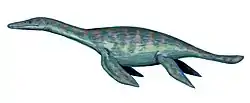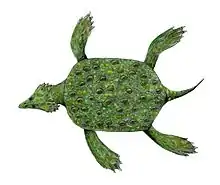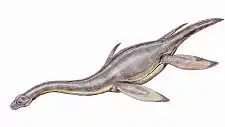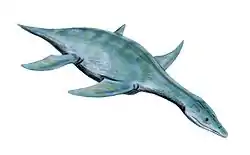Macroplata
Macroplata (meaning "big plate") is an extinct genus of Early Jurassic rhomaleosaurid plesiosaur which grew up to 4.5 metres (15 ft) in length. Like other plesiosaurs, Macroplata probably lived on a diet of fish, using its sharp needle-like teeth to catch prey. Its shoulder bones were fairly large, indicating a powerful forward stroke for fast swimming. Macroplata also had a relatively long neck, twice the length of the skull, in contrast to pliosaurs.[1][2]
| Macroplata | |
|---|---|
 | |
| Restoration of Macroplata tenuiceps | |
| Scientific classification | |
| Kingdom: | |
| Phylum: | |
| Class: | |
| Superorder: | |
| Order: | |
| Family: | |
| Genus: | †Macroplata Swinton, 1930 |
| Binomial name | |
| †Macroplata tenuiceps Swinton, 1930 | |
A different species, Macroplata longirostris (previously called Plesiosaurus longirostris), which lived somewhat later, during the Toarcian stage, was also included in the genus; however, in 2011, Benson et al. reclassified it as a pliosaurid in the genus Hauffiosaurus, H. longirostris.[3]
Description
Macroplata bore an elongated skull, with more than half of its cranial length taken up by a roughly triangular snout. The premaxillae (front upper jaw bones) bear six teeth each. Together, they form the rounded region at the front of the jaw, and have a rough outer surface bearing foramina, ridges, and grooves. The snout is constricted where the premaxillae border the maxillae (the larger upper jaw bones). These bones continue to contact each other until they reach the level of the external nares (openings for the nostrils). While the premaxillae become narrow beyond this point, they extend far back on the skull, forming a ridge rearward of the external nares. The top side of each maxilla is ornamented like that of the premaxillae. The front edges of the orbits (eye openings) are formed by the maxillae. The maxillae also seem to make up the front and outer rims of the external nares, although poor preservation makes it difficult to verify this.[4]
The frontals of Macroplata are long, spanning from external nares to temporal fenestrae (large openings at the back of the skull), and widen towards the back of the skull. They bear foraminae and probably formed the rear edges of the external nares. The frontals are separated from each other by the premaxillae in the front and the parietals (bones at the back of the skull roof) at the rear, with a small area of contact between. The frontals articulate with the prefrontals above the orbits. The prefrontals form part the orbits' upper edge. The postfrontals form the border between the orbits and the temporal fenestrae, and each bone bearing a ridge running perpendicularly to the skull's length. Upon the discovery of Macroplata, its pineal foramen was claimed to be both large and small by different sources. As it was later obscured by plaster, its true size is unknown.[4]
Classification
Following Benson et al. (2012):[5]
| Plesiosauria |
| ||||||||||||||||||||||||||||||||||||||||||||||||||||||||||||||||||||||||||||||||||||
References
- Ketchum HF, Benson RBJ. Global interrelationships of Plesiosauria (Reptilia, Sauropterygia) and the pivotal role of taxon sampling in determining the outcome of phylogenetic analyses. Biological Reviews
- Palmer, D., ed. (1999). The Marshall Illustrated Encyclopedia of Dinosaurs and Prehistoric Animals. London: Marshall Editions. p. 76. ISBN 1-84028-152-9.
- R. B. J. Benson, H. F. Ketchum, L. F. Noe and M. Gomez-Perez. 2011. "New information on Hauffiosaurus (Reptilia, Plesiosauria) based on a new species from the Alum Shale Member (Lower Toarcian: Lower Jurassic) of Yorkshire, UK". Palaeontology 54(3):547-571.
- Ketchum, H. F.; Smith, A. S. (2010). "The anatomy and taxonomy of Macroplata tenuiceps (Sauropterygia, Plesiosauria) from the Hettangian (Lower Jurassic) of Warwickshire, United Kingdom" (PDF). Journal of Vertebrate Paleontology. 30 (4): 1069–1081.
- Roger B. J. Benson, Mark Evans and Patrick S. Druckenmiller (2012). "High Diversity, Low Disparity and Small Body Size in Plesiosaurs (Reptilia, Sauropterygia) from the Triassic–Jurassic Boundary". PLoS ONE. 7 (3): e31838. doi:10.1371/journal.pone.0031838. PMC 3306369. PMID 22438869.CS1 maint: uses authors parameter (link)





.png.webp)